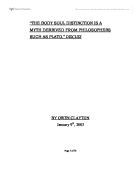Critically discuss Lockes distinction between Primary and Secondary Properties
Critically discuss Locke’s distinction between Primary and Secondary Properties
John Locke (1632 – 1704) was an empiricist and therefore he was against the rationalist way of thinking. Rationalists believe that we gain knowledge about the world through two areas. The first of these areas is that we have innate knowledge, knowledge that we are born with. The concept of innate ideas, assumes that from birth a certain amount of knowledge is present. Although this is the case, Empiricists believe that the mind is in fact a blank slate. When we learn things, our mind is in a sense being written on. The second of the areas is when knowledge is gained through experience via the senses.
In contrast to this, Locke and other empiricists believe that there is no such thing as innate knowledge. Everything we perceive about this world is perceived via the senses. Locke described the mind as ‘white paper, void of all characters, without any ideas’. This theory can be related to Plato (347 BC) who said’ there is nothing in the mind except what was first in the senses’ and is the essence of the empirical way of thinking which is put forward mainly by Berkeley and John Locke.
John Locke expanded upon the idea that knowledge is gained via sensory experience stating that there are simple ideas and complex ideas. We have a number of simple ideas about an object which you then reflect upon and combine to form complex ideas. An example of this would be, if you have an idea about the desk you are sitting at being brown, then have an idea of your teddy bear being brown and, if you combine the two simple ideas of these brown objects, you’ll gain a complex idea of the colour brown. Additionally, Locke stated that although this is the case, some information should not be trusted; he expounded this into his theory of Primary and Secondary qualities.
Locke believed that though we experience everything via our senses, the information itself falls into two categories which are the Primary and Secondary qualities. Primary qualities are objective and according to Locke, can be trusted. Things such as shape, number and motion are that of primary qualities and can be trusted as they are supported by fact. However sensation, colour and taste are examples of secondary qualities. These are subjective as they can differ from person to person, for example I notice Jen who is wearing a jumper and jeans and has curly hair; her height, weight and number of limbs are primary qualities whereas the colour of Jen’s jumper, jeans and hair are secondary qualities. Thus, according to Locke there are only primary qualities in an actual object such as size, shape, etc. Secondary qualities do not exist in the actual object and do not resemble the object itself – therefore not necessary. To better describe this difference, consider this example; ‘I see a small bird flying above me, the bird is actually significantly bigger but because of my perspective it appears small’. Locke states that the size of objects in the external world is the cause of his sensation of size, albeit if the size is not the same as he perceives it. This perception was first established by Descartes which was then continued by Locke.







